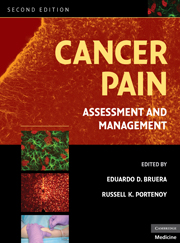Book contents
- Frontmatter
- Contents
- Contributors
- Preface
- SECTION I MECHANISMS AND EPIDEMIOLOGY
- SECTION II EPIDEMIOLOGY AND SYNDROMES
- SECTION III ASSESSMENT
- SECTION IV PHARMACOLOGICAL TREATMENT
- SECTION V OTHER INTERVENTIONAL STRATEGIES
- SECTION VI REHABILITATION AND PSYCHOLOGICAL INTERVENTIONS
- SECTION VII THE ROLE OF ANTINEOPLASTIC THERAPIES IN PAIN CONTROL
- SECTION VIII PAIN IN SPECIAL POPULATIONS
- SECTION IX DIFFICULT PAIN PROBLEMS
- SECTION X SYSTEMS OF CARE
- 29 Integrating cancer pain management into hospice practice and institution-based palliative care programs
- 30 Pain in medical illness: ethical and legal foundations
- 31 Understanding clinical trials in pain research
- 32 Legal and regulatory aspects of opioid treatment: the United States experience
- 33 Role of family caregivers in cancer pain management
- 34 Cancer pain and palliative care in the developing world
- Index
- Plate section
- References
30 - Pain in medical illness: ethical and legal foundations
from SECTION X - SYSTEMS OF CARE
Published online by Cambridge University Press: 06 July 2010
- Frontmatter
- Contents
- Contributors
- Preface
- SECTION I MECHANISMS AND EPIDEMIOLOGY
- SECTION II EPIDEMIOLOGY AND SYNDROMES
- SECTION III ASSESSMENT
- SECTION IV PHARMACOLOGICAL TREATMENT
- SECTION V OTHER INTERVENTIONAL STRATEGIES
- SECTION VI REHABILITATION AND PSYCHOLOGICAL INTERVENTIONS
- SECTION VII THE ROLE OF ANTINEOPLASTIC THERAPIES IN PAIN CONTROL
- SECTION VIII PAIN IN SPECIAL POPULATIONS
- SECTION IX DIFFICULT PAIN PROBLEMS
- SECTION X SYSTEMS OF CARE
- 29 Integrating cancer pain management into hospice practice and institution-based palliative care programs
- 30 Pain in medical illness: ethical and legal foundations
- 31 Understanding clinical trials in pain research
- 32 Legal and regulatory aspects of opioid treatment: the United States experience
- 33 Role of family caregivers in cancer pain management
- 34 Cancer pain and palliative care in the developing world
- Index
- Plate section
- References
Summary
No moral impulse seems more deeply embedded than the need to relieve suffering…it has become a foundation stone for the practice of medicine, and it is at the core of the social and welfare programmes of all civilized nations.
Daniel CallahanIntroduction
By introducing major modifications in the historical constructs underlying medical treatments, science and technology have created a certain “chaos” in the care of seriously ill patients. What might have been considered good medical practice for advanced disease before the “biological revolution” is now questioned. Where to draw the line? Where to set limits? Many variables now must be considered in the management of patients with advanced illnesses, including the recognition of ethics as a foundation for clinical practice, the acknowledgment of new rights, and social changes related to health care. Ethical and legal considerations now must constantly inform decision making. Medicine has been caught in a difficult dilemma: Not only does it have to consider its own complexities, but it also has to face a much different social context than existed just a short time ago.
Numerous ethical guidelines and recommendations have been proposed by diverse authorities to help clinicians in their decision making. Recommendations can be found in reports of special presidential or national commissions, in major congressional reports, in policy statements of national organizations, in guidelines from bioethics institutes, and in professional journals.
- Type
- Chapter
- Information
- Cancer PainAssessment and Management, pp. 553 - 567Publisher: Cambridge University PressPrint publication year: 2009



